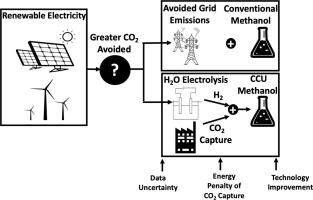Applied Energy ( IF 11.2 ) Pub Date : 2020-09-18 , DOI: 10.1016/j.apenergy.2020.115770 Dwarakanath Ravikumar , Gregory Keoleian , Shelie Miller

|
Carbon capture and utilization (CCU) to produce methanol is a beneficial pathway to use carbon dioxide (CO2) and mitigate climate change. Existing life cycle assessments demonstrate that CCU methanol generates a net CO2 benefit when the hydrogen (H2), required for hydrogenating the captured CO2, is generated by electrolyzing water using renewable electricity (RE). However, the findings do not account for the environmental opportunity cost when RE can be supplied to the grid to offset CO2 intensive electricity instead of electrolyzing water, the energy penalty of capturing CO2 and the scope for technological improvement. This study quantifies the environmental opportunity cost and determines the net CO2 emissions when CCU methanol offsets the production of conventional methanol across 14 scenarios. The 14 scenarios account for capturing CO2 from 3 sources (combined and conventional natural gas, and coal power plants) and generating H2 with electricity from 3 sources (photovoltaics, wind and the grid). The CO2 avoided by using RE on the grid is greater than that from producing CCU methanol by 660 to 11960 kg CO2/ton methanol across the 14 scenarios. Unless the grid CO2 intensity drops below 67 g CO2/kWh, it is environmentally preferable to supply RE to the grid than for use in CCU methanol production. At the thermodynamic limit of CCU methanol production, the grid CO2 intensity should be lower than 82 g CO2/kWh, which is unlikely in the US before 2050.
中文翻译:

使用可再生能源进行碳捕集和利用来生产甲醇的环境机会成本
碳捕获和利用(CCU)生产甲醇是利用二氧化碳(CO 2)和缓解气候变化的有益途径。现有的生命周期评估表明,当通过使用可再生电力(RE)电解水生成氢化捕获的CO 2所需的氢(H 2)时,CCU甲醇会产生CO 2净收益。但是,当可以将RE提供给电网以抵消CO 2密集的电力而不是电解水时,该发现并未考虑环境机会成本,这是捕获CO 2的能量损失。以及技术改进的范围。这项研究量化了环境机会成本,并确定了CCU甲醇抵消了14种情况下常规甲醇的生产时的净CO 2排放量。这14种情况说明了如何从3种来源(混合天然气和常规天然气以及燃煤发电厂)捕获CO 2,并用3种来源(光伏,风能和电网)的电产生H 2。在这14种情况下,通过在电网上使用RE避免的CO 2大于产生CCU甲醇的660至11960 kg CO 2 /吨甲醇。除非栅格CO 2强度降至67 g CO 2以下/ kWh,向环境中供应可再生能源比在CCU甲醇生产中使用更可取。在CCU甲醇生产的热力学极限下,电网CO 2强度应低于82 g CO 2 / kWh,这在美国到2050年之前是不可能的。


























 京公网安备 11010802027423号
京公网安备 11010802027423号